Bridgescore+ - Atlanta Regional - August 29 - September 4, 2017
KO Events
Bridgescore+ (BS+) started all of the KO events.
There were no issues.
D7 has now started hundreds of KOs.
BS+ ran several Swiss events.
BS+ ran all 3 Swiss events on the final day.
BS+ ran some Swiss events with player input for team scores - BS+ can now run a Swiss event from start to finish with no TD interaction.
Equipment
We (Hammond Software) have 2 projectors; D7 has 2 projectors, one of which is not very powerful and was not used.
Our projectors are "old" (about 4-5 years old) and pre-date the short-throw technology.
D7 has a short throw projector.
A short throw projector can throw a bigger image at a shorter distance than the traditional projectors, however they tend not be as powerful (bright) as the regular projectors.
Bracketed Swiss Events
ACBLscore was used to start a bracketed Swiss early in the tournament, but Bridgescore+ was used to start the second one.
The table space was AA1-DD16, EE1-GG16.
Having started a few KOs already we knew that tables AA12, CC12 were used for the projector.
We also knew that table AA16, CC16, CC15 had bad light.
An important part of setting up a bracketed Swiss is making sure that the table assignments are easy for both the players and the directors.
We took an extra couple of minutes in assigning the teams to the tables.
With a bracketed BCD Swiss, ACBL rules are that the bottom bracket must have all the overflow teams; with a regular bracketed Swiss, ACBL rules are that the DIC decides if the bracket is at the top, or at the bottom.
D7 generally puts the overflow teams in the top bracket for a regular (no top limit) bracketed Swiss.
D7 used the common index number technique were the original team number (sales started at 201) is mapped to a new unique number.
There were 15 teams in the top bracket, and 9 team brackets for all other brackets.
This was a 2 session event so 8 rounds.
The bottom brackets are run as 3 round robins for each pair of rounds.
This allows plenty of time to setup the event.
With 15 teams in the top bracket, Bridgescore+ gave the DIC a choice of how many round robin (RR) and how many head to head (HH) tables he wanted in the first round.
He chose to have 5 RRs. This made it much easier on the caddies.
Normally they would have used 1 RR, 6 HH but this approach made the first two rounds nice and smooth.
There was some confusion with the setup, fortunately mitigated by Bridgescore+.
All week tables EFG had been used for HH matches and as RR tables.
For experienced players, if your home table is F1, and you are in a round robin, then you "know" that the setup is
D1->E1->F1.
This was not the setup for Atlanta - the setup was
E1->F1->G1.
Bridgescore+ displays (in yellow) that you are in round robin and displays both tables for the RR.
This helped mitigate players going to the wrong tables.
A tip for other tournaments, and other D7 regionals, is to try and avoid start letters for a RR that are not part
of the regular box.
For example, the space may have been better laid out as AA1-DD16, and GG1-II1.
Comments
For the start of the first KO, we had 3 projectors in use - one in room AA/BB, one in room CC/DD and one by the selling station.
The light at the selling station was not good, we used the short-throw projector and it was difficult to read.
The background was not conducive to a good display.
The other problem was that the players hovered around the TD station.
We only put the projector up front one day, the remaining days we used projectors in each of the rooms.
ACBLscore Game Files
For some of the Swiss, and some of the KOs, D7 sent the game files created by Bridgescore+.
ACBL Live did not know the difference.
This means that in the future, we do not need to run ACBLscore in parallel.
For team events, BS+ has much more efficient ways of entering player names, including Bridgemates and other options.
Multiple events at the same time
In 2016, I had run all 3 Monday Swiss in parallel with ACBLscore, but ACBLscore was the primary computer.
I wanted to see if Bridgescore+ could easily handle 3 events at the same time,
not as much from the software side, but more from the user interface side.
There were no problems.
In 2016, ACBL needed 1 TD for most of the event to keep track of table assignments; during round changes, starting approximately 10 minutes before and 5 minutes afterwards, there were at least 2 TDs. At some times there were 3 TDs during round change, one entering the scores, one entering the assignments on the rack and one on the Jeffrey's chart (score board).
I would estimate that between 1 and 1.25 TDs were needed, just to run the technology side of the event.
For 2017, Bridgescore+ was the primary for all 3 Swiss. The events were set up before the players were there.
We knew the table assignment. We set up 3 projectors.
We set up the projectors inside the playing area, on a far wall.
There was no-one playing on the back wall (except someone who needed an electrical outlet).
All scores were turned in outside the playing area, but the results and assignments were on projectors inside the room.
This is where the short-throw projector came into its own.
It was used for the AX Swiss and the assignments were easy to read.
We used our 2 projectors for the BC and Gold Rush (GR) Swiss.
Although they could be read, and were brighter sharper images, the short throw was easier to reach at a distance.
As BS+ handles all assignments, and is essentially on auto-pilot once the event is set up, there was little to do.
I would estimate that it was about 0.25 TDs; most of which was player name entry.
New Features
At all tournaments, I try and learn more about how TDs (and players) use Bridgescore+.
This tournament was focusing on how TDs use the software, what they want, how they expect it to run.
It may seem late in the game for this, but the underlying software works very well, there are minor tweaks for the UI.
During the ACBLscore+ project, ACBL did not allow much feedback from TDs.
Based on the comments and feedback, I've made many changes over the last 2-3 weeks, mostly subtle but all intended to make the software easier to navigate and easier to use.
Also wanted to see how much we can get the players to use Bridgescore+ and their feedback.
This was very positive.
Almost all players could use Bridgescore+ with no explanation on how to use it.
Player Entry of Team Results
Bridgescore+ is self-standing for Swiss events.
Once the table inventory is in, and the number of teams is known, and the first round assigned, everything is automatic.
Bridgescore+ will automatically assign matches using the published ACBLscore algorithm for the next round.
The projector will automatically roll from one round to the next when assignments are posted.
All that is needed is the team results.
On many occasions I had the teams enter their scores.
The interface is nice and simple - enter team number, it then displays the opponent team number then you enter the score.
Scores are corrected by re-entering them.
There is a safety check - the total score for all teams is posted on the projector.
I had little problem showing the players the screen and asking them to enter the scores with no instructions.
What this means is that, assuming no problems (!), the TD can set up the Swiss event, and it will run itself
with the teams entering the scores.
We can use a simple tablet (does not need to be fully powered computer) for doing team score input.
In fact, part of the time I did have a cheap android tablet and asked teams to enter their scores.
There were several rounds that were done this way, without knowledge of the players or the TD.
Everything is automatic.
The long term benefits are that the TD does not need to be at the TD table at the end of a Swiss.
The players can enter the scores.
Of course, the TD must be available on error, but this is no different than what happens at the moment with
Bridgemates in a Pair event.
Late Results
Bridgescore+ time stamps most data entry, including the time that a result was turned in.
For an 8 board round, ACBL mandates a 64 minute limit. 8 minutes per board.
The next round officially starts when the final assignment for the next round is posted.
With ACBLscore this can be a few minutes as matches have to be assignment, then posted to the rack.
One of the events (it was an AX so no complaints about slow players) was run this way.
The players were all informed through announcements made in both playing rooms that it was a timed event, and they had 64 minutes to turn in their results.
The projected display includes a timer for the round.
With 10, 5 and 2 minutes to go in each round, the TD went into each room and made the announcement of how long was left before the end of the round.
The software knows exactly the start of each round, and the end of each round.
All teams that were late were issued a penalty. ACBL policy is that the first late return is a warning. Subsequent late returns of scores results in a progressively higher VP penalty.
There is little room for error - the computer has the clock, it is set at the start of each round, all players were given notice that late play penalties were in play.
There was one team that was late for the first 3 rounds. Of course, it was not their fault, the team at the other table was slow. They were the only team that was late for the first 3 rounds. They may only have been late by 2-5 minutes, but this affects all players as the last round of assignments is held up waiting for the last result.
Bridgescore+ posts the assignments faster than ACBLscore as everything is automatic.
Another team that was habitually late was a prominent D7 board member. Again, it was never his/her team's fault - it was always the other team's fault.
Technology is a curious tool. Most people like it, but when it starts to affect them, they get upset.
There was much complaining from some (only 2-3) of the more vocal D7 board members - there was no clock (it was prominent on the display) - there were no announcements (2 announcements before start of the event, 3 at the end of each round) - we were not given a warning ("if you haven't entered your score by now, you are late!") - we didn't hear anything (the DIC of the event just looked at them incredulously) - it's not fair (quite right, it's not fair that you are habitually holding everyone else up with your slow play, but I didn't say anything).
In the past, it was difficult for the TDs to track late plays. "Dots" were assigned on the Jeffrey's chart but these were arbitrary. There could be no proof that the clock started on time. TDs have been known to 'shave' time off clocks to get players to finish quicker. Bridgescore+ is different - all of this is tracked and auditable.
Bridgescore+ can print out the exact time that the round started, and when the results are turned in.
Politics won out. There were no more late plays issued that event (it was a 2 session Swiss event).
For many players, this may have been the first time that they have been made aware that they are slow players. If they have a perception (which some did) that they are fast players, then this is an even bigger problem to explain to them. They think they are fast, but they are slow. How are they going to speed up?
The DIC was very gracious with the late plays - a couple of times they were not awarded because of director calls that took some time to resolve, but otherwise the DIC was firm. It will be interesting to see how this plays out in the long run. I hope politics does not win out - the ACBL policy does not allow for much DIC discretion for late plays.
Bridgemates
Did not use them at this tournament.
Bridgescore+ has been able to run team events with Bridgemates for the last 18 months so there is little for us to learn from their use.
D7 apparently has recently purchased more Bridgemates so that we can run team events during the week with Bridgemates.
This will make data entry much easier (e.g. player name entry).
Hand Records for Team Events
There is little interest in D7 for this feature.
Cameras for Team Events
Again, little interest from D7 for this.
We have the software and the hardware.
It is of little value without the hand records.
I think this is excellent for marketing reasons. I would only put camera on Bracket 1 of KOs.
Experience has shown that nearly all players give off UI knowingly or not.
Bugs - Bridgescore+
I always try to be upfront with all issues. I had re-written the code that handles round-robins to make it easier to follow. Unfortunately there was a bug that when a KO was started that displayed the next round of a RR so that instead of A1->B1->C1 it displayed A1->C1->B1. It was a very simple fix (two characters), but annoying to have. Normally KOs are kept in the pre-game state until everyone is playing. The tables were correctly displayed in the pre-game state.
It was a simple fix.
Bugs - ACBLscore
It was funny (sadly amusing) to watch the TDs use ACBLscore to run some of the events. They had to go into DOS mode, then Windows mode to correct different functionality. Often there would be 3 of them over the computer trying to figure out what to do.
ACBLscore is a closed compiled system making software support difficult.
I did not write down any specific problems.
I know well enough that if a TD is dealing with a problem, they are best left alone.
Bugs - Masterpoints
There are some bugs in the spreadsheet that ACBL is using to calculate the masterpoints.
As such, Bridgescore+ was generating different masterpoints than ACBL for some events.
A reading of the MPBOOK shows that Bridgescore+ was correct.
Unfortunately, ACBL's spreadsheet is 'correct' so for some games/game types we could not use the Bridgescore+ ACBLscore game files, and they had to be done using ACBLscore.
In most cases, ACBLscore was under-awarding MPs (because of rounding errors).
An alternative explanation is that the MPBOOK is wrong (it is known to have several inaccuracies).
Other
I had a large 11x14 printer with me. Unfortunately it broke. This is the 5th printer I have traveled with that has stopped working. There is something to be said for the carriage printers...
The only other laser printer was in the TD office so we did not use Bridgescore+ was printing any items hung on the wall.
This is an area where we need some feedback from TDs/players - what information do players really want.
Photographs
The photograph below shows projection onto the brick wall close to the selling station on day 1.
We used this for the KO.
The sun came through a skylight making it difficult to read.
We only used this on day 1.
Setup for day 1 takes a little longer than the other days because you need to find the best (safest) location
for the event.
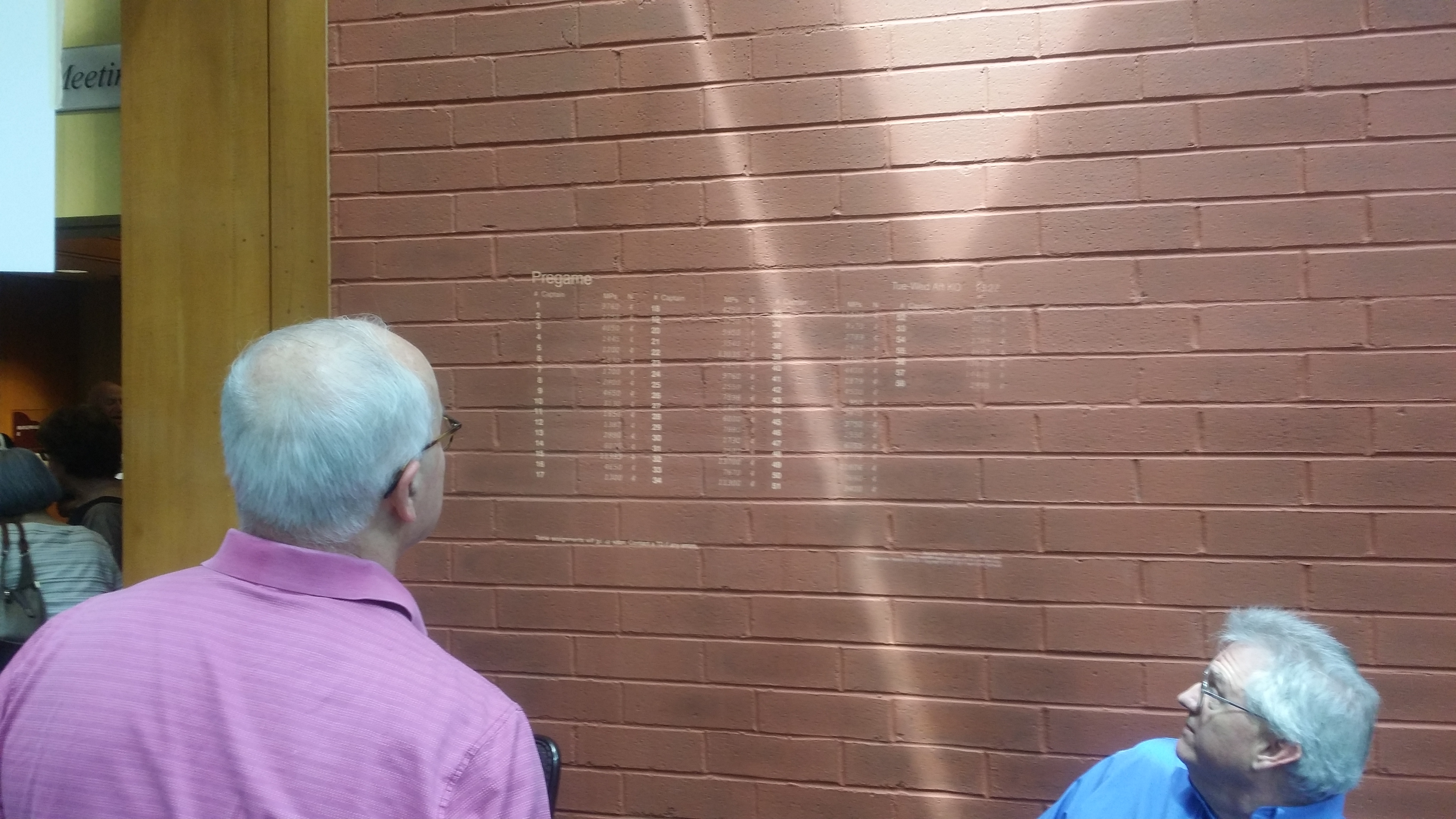
Same view, only with the assignments up.
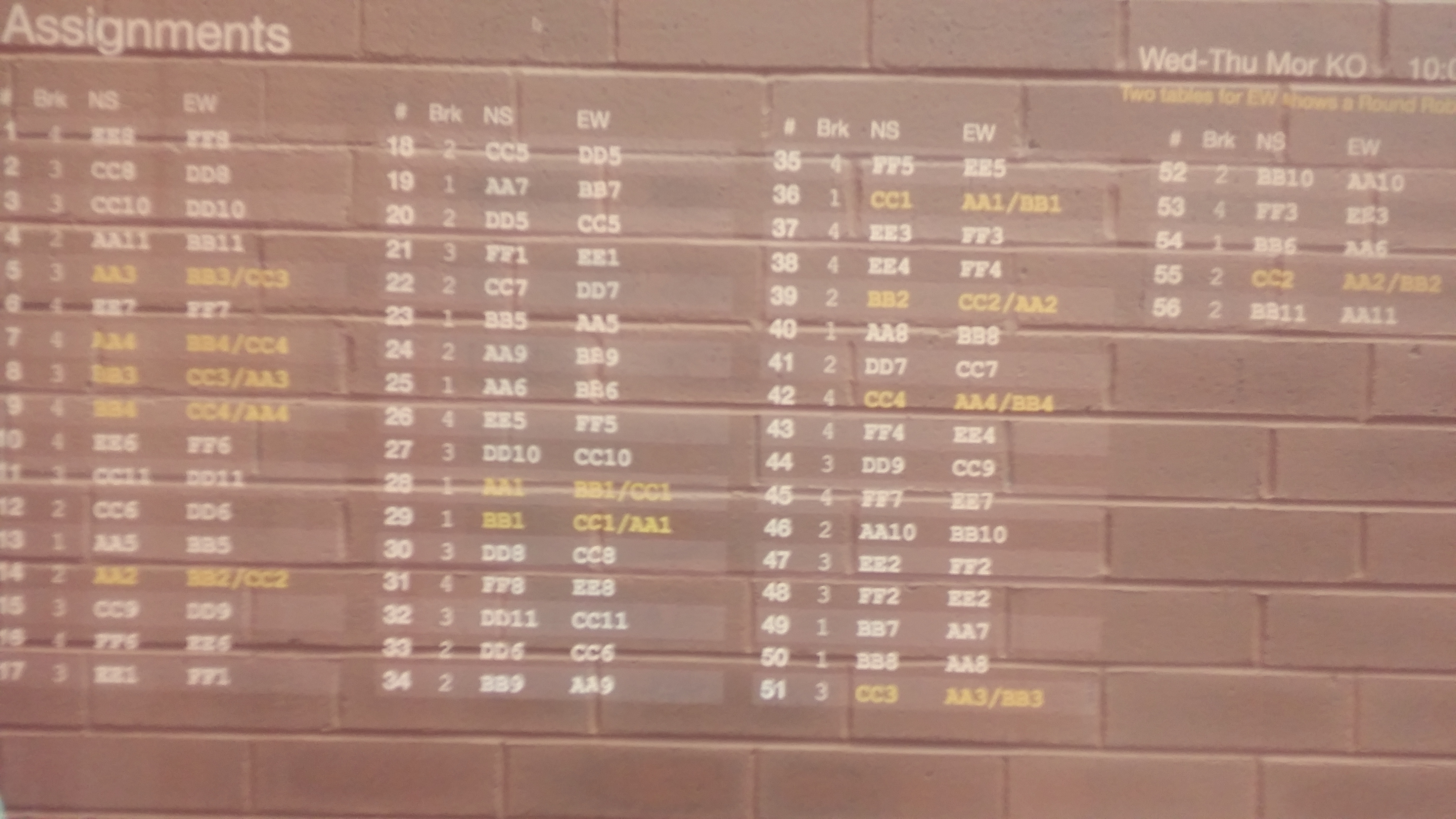
This is the projector in the AA/BB or CC/DD room.
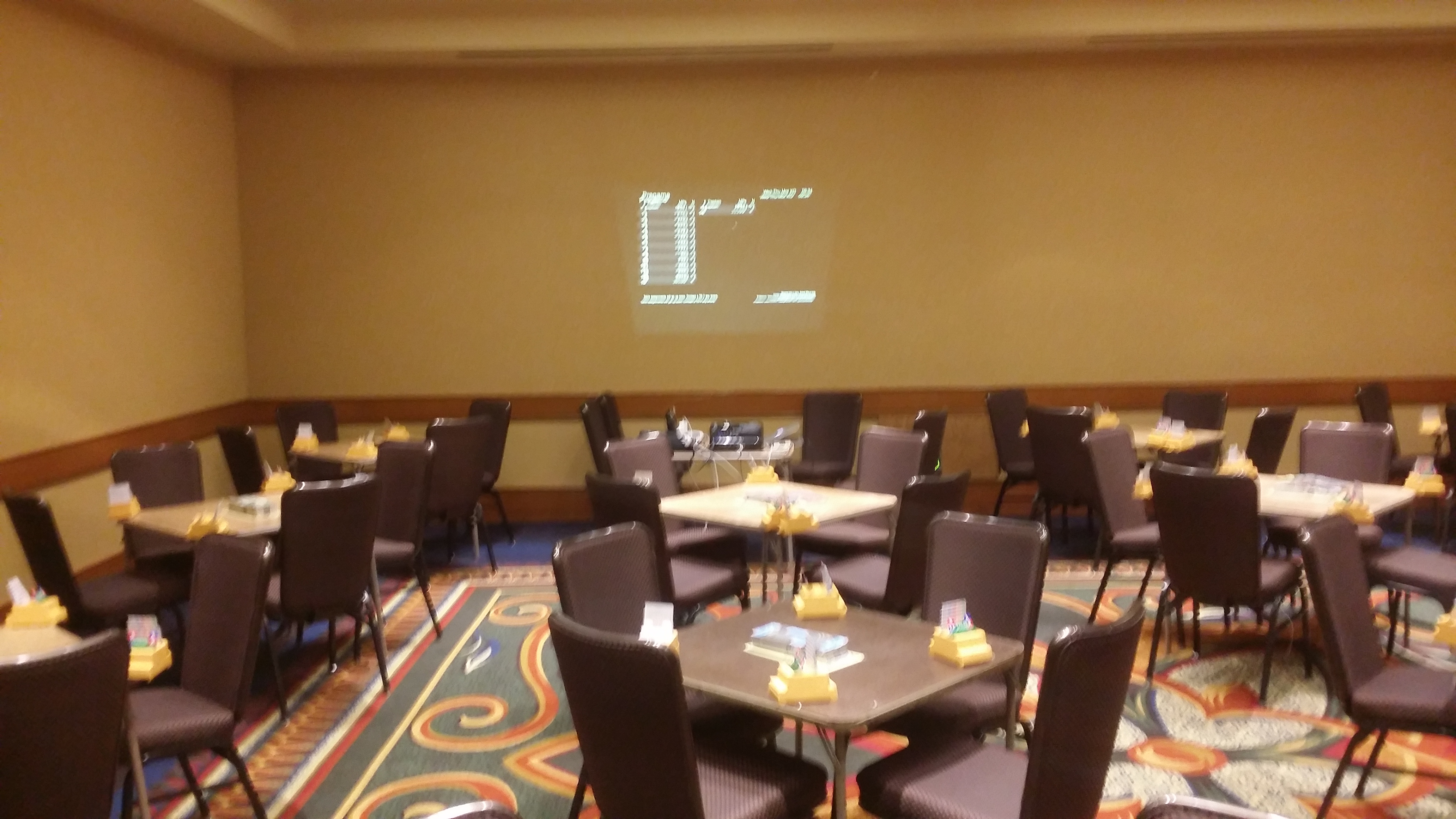
Shows the setup - a computer driving a projector. Chairs are put close to the wall to stop players walking by.
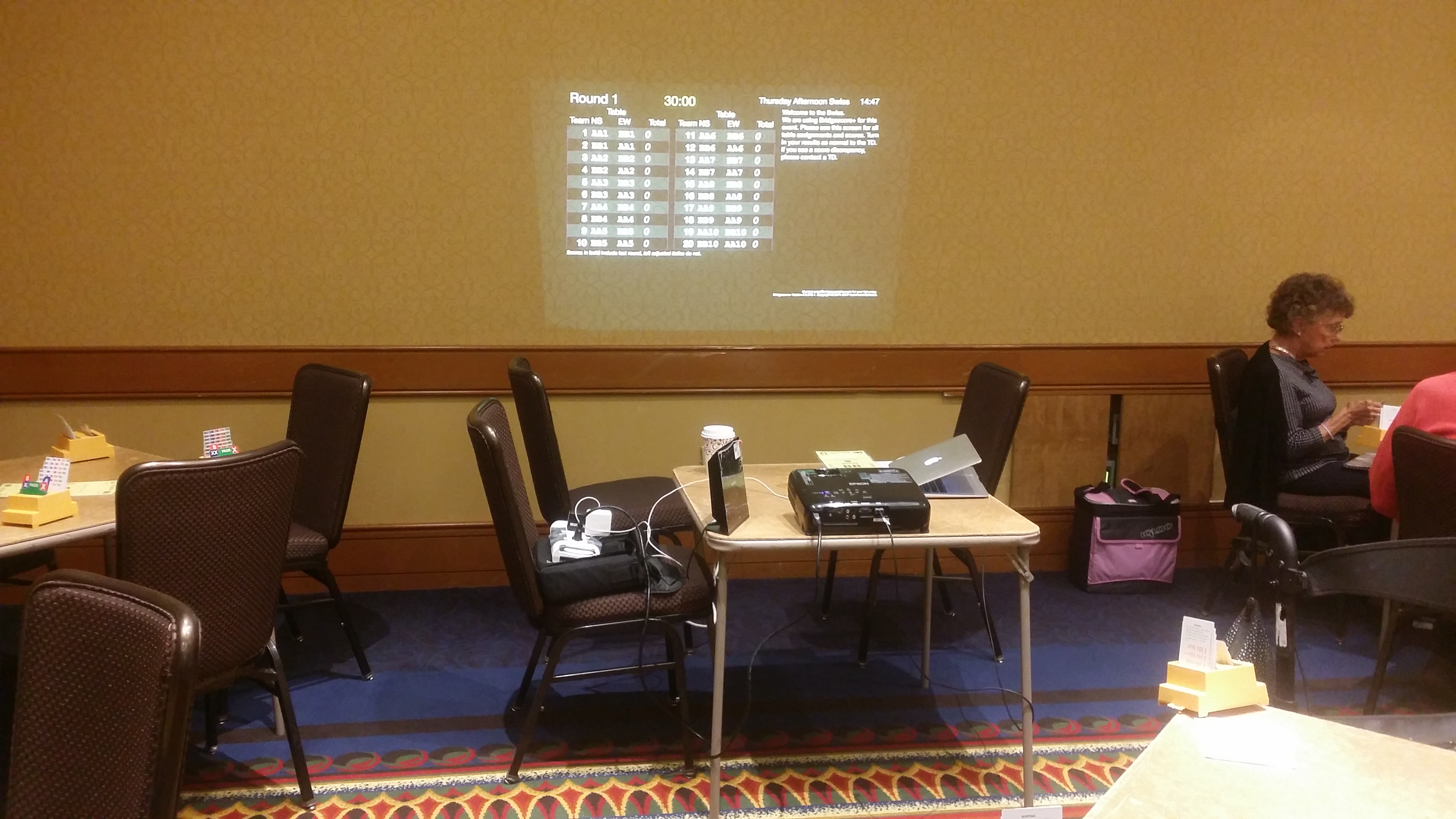
Shows the projector during actual play.
Note that the players are all on one side of the room.
The lighting was not as good on the near side.
Bridgescore+ lets you configure which tables to use first when assigning tables.
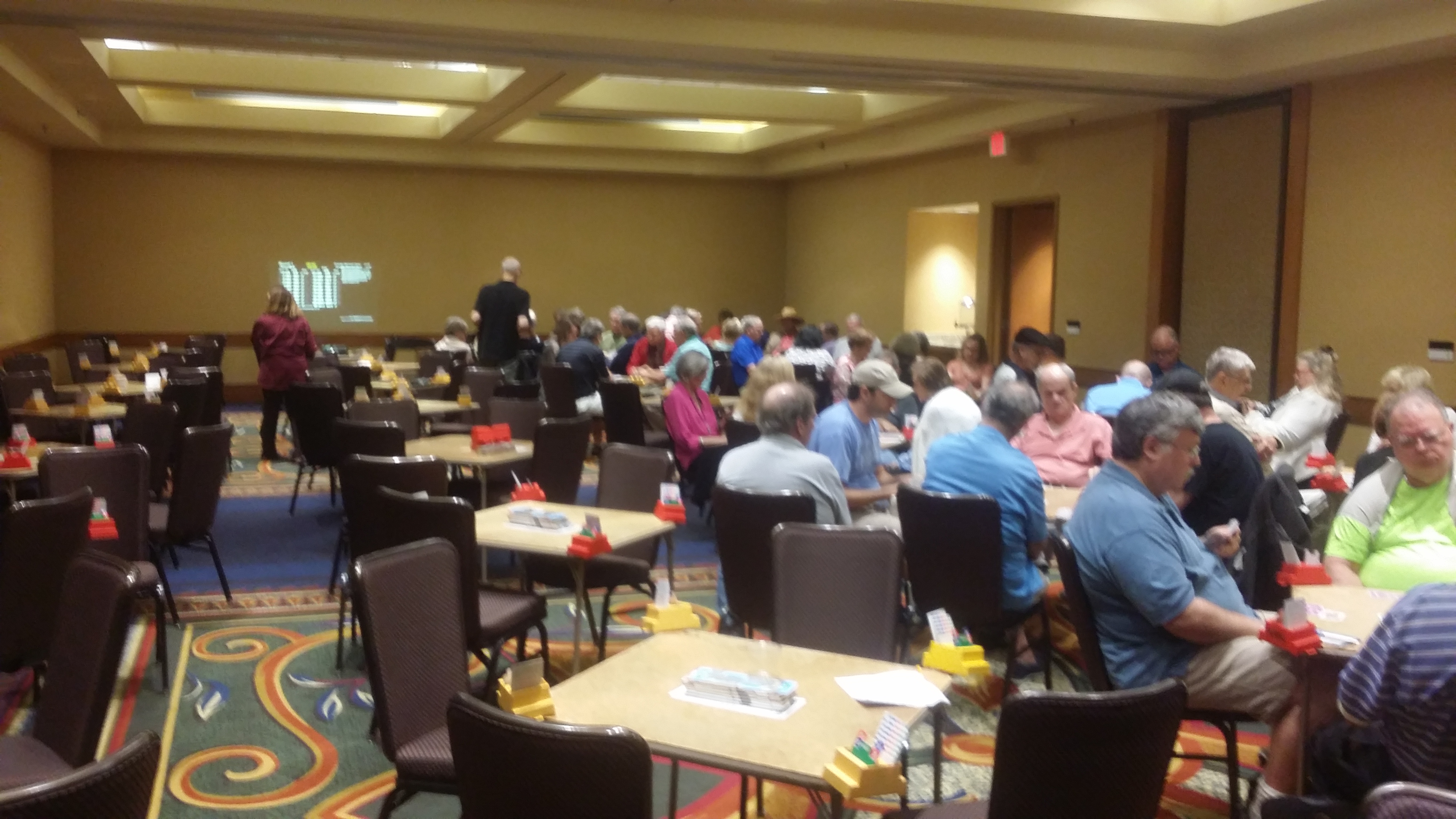
This is the results area for the Monday 3 event Swiss.
Very quiet...
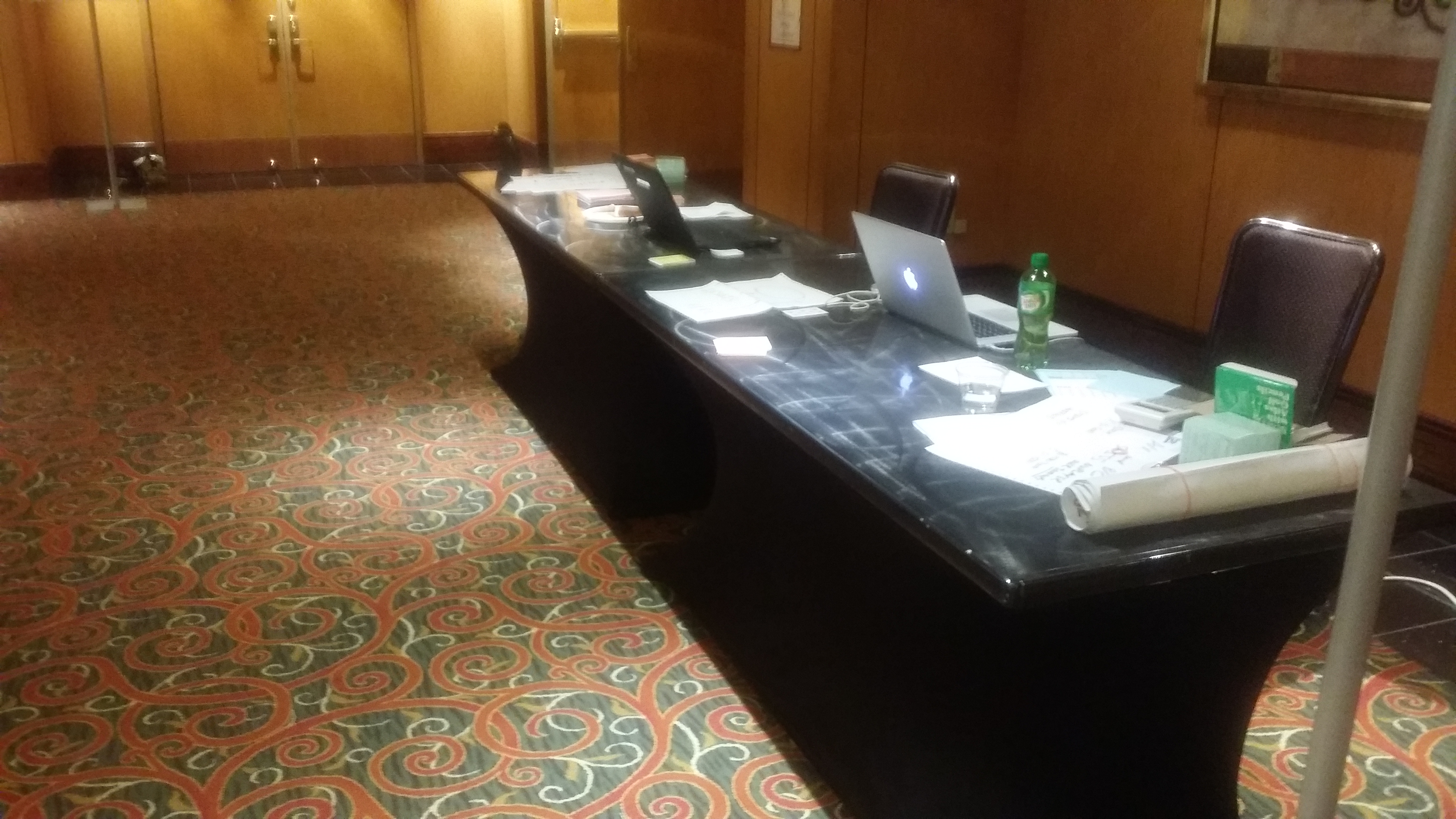
This is the playing area for Monday.
On the left is the AX Swiss with a projector on the wall behind the D stanchion.
This projector is the short-throw.
In the middle, underneath two bright downward lights is the BC Swiss, to the
right of the pillar underneath the other two bright downlights is the Gold Rush Swiss.
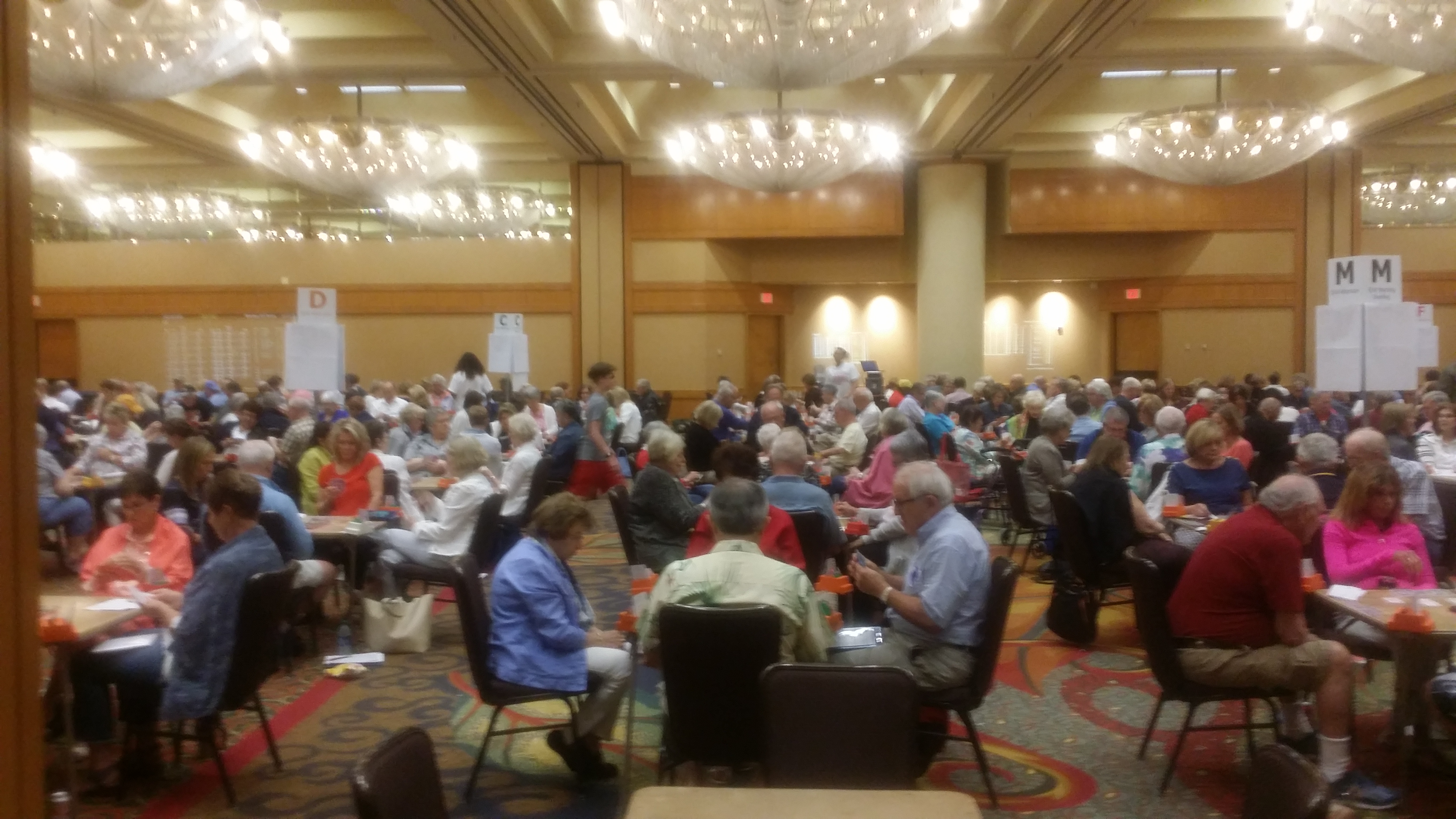
This is the Gold Rush Swiss close up.
It is possible to see the assignments for Round 4 with the running scores.
Each team can check their scores as well as the top teams displayed on a leaderboard.
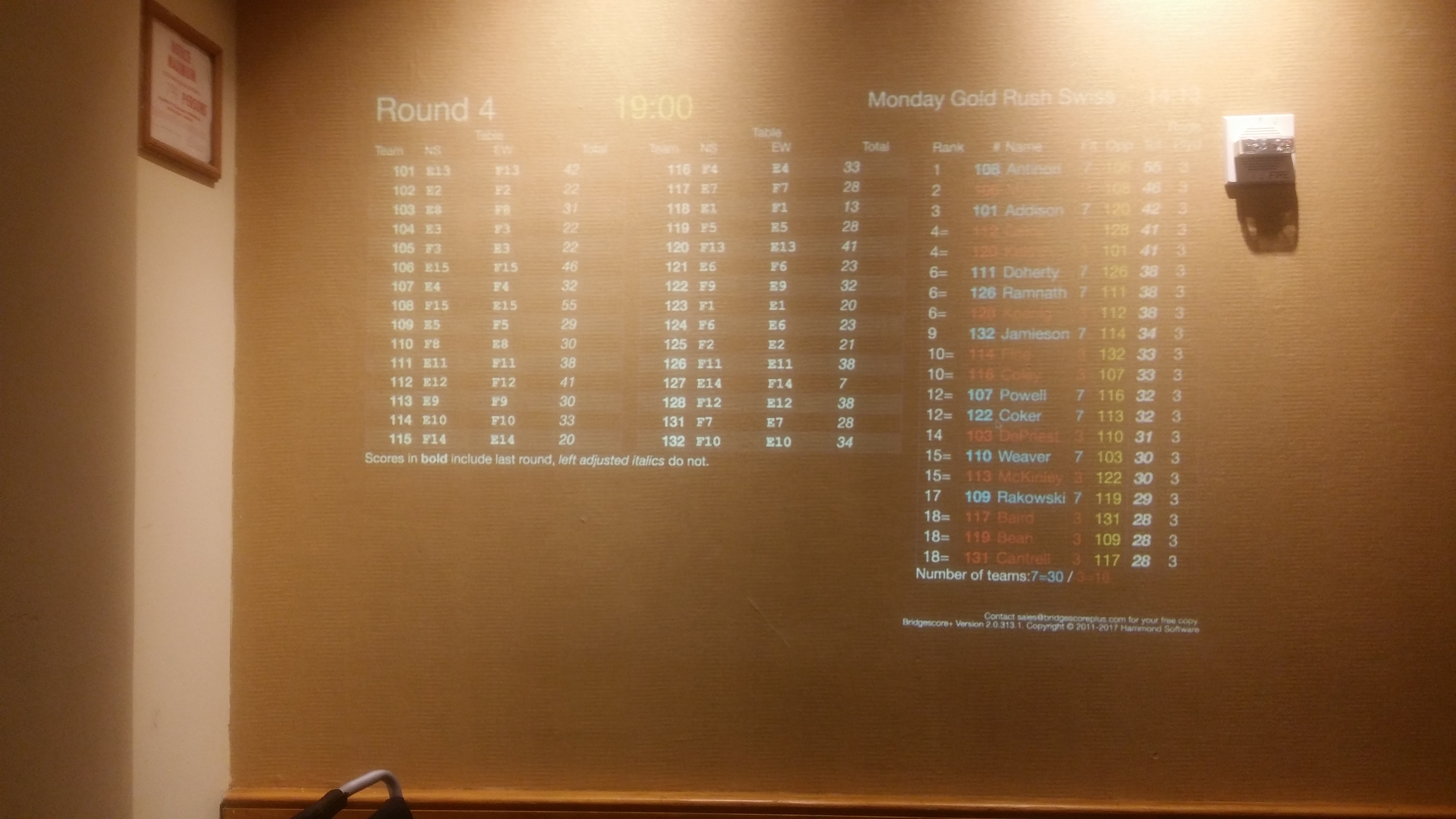
This is at the end of the event.
No-one is crowding around the TD area.
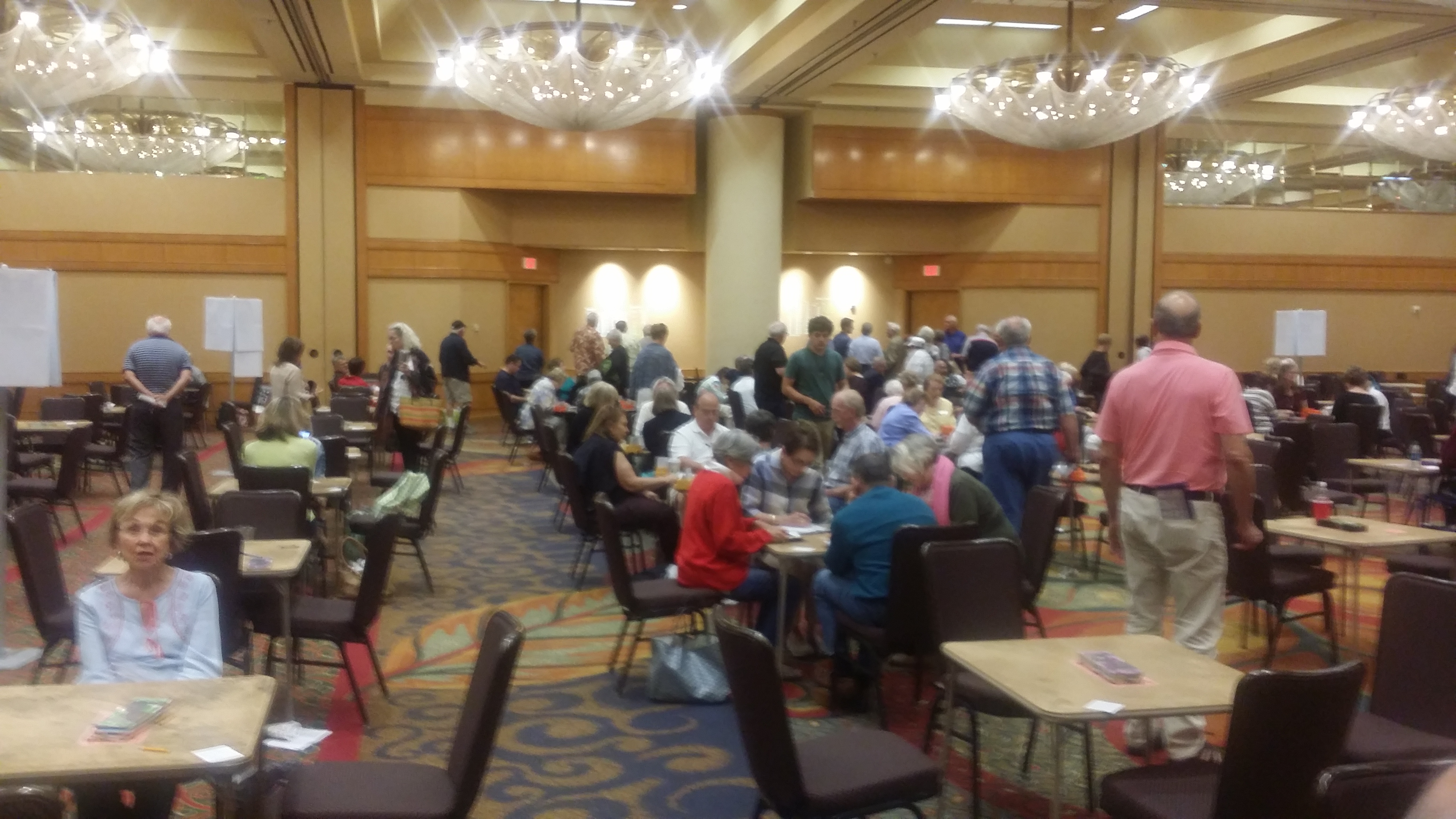
Next?
There were lots of minor issues that were pointed out that I'm going to fix in BS+.
There were a couple of issues that I want to fix - mostly in making the software easier to use.
Once these are done, I'll make a version more generally available.









